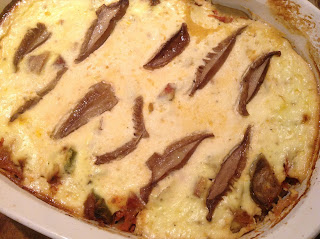by Mary Ellen
Swiss chard is always the last thing from the garden that I prepare for the freezer because it stands up so well to frost that I can put off harvest for weeks and weeks and weeks. "If it weren't for the last minute, nothing would get done," said Rita Mae Brown. But with all things biological, timing is everything and when I finally made it out to the garden this is what I found:
 |
| Here is what is left of our garden's gorgeous leafy "Bright Lights" chard. |
The good thing about my garden discovery is that it took me past an old Blewit bed that I had made years ago. Sometimes I need a little inspiration when it comes to cooking. Homegrown, fresh harvested vegetables usually provide the spark needed to initiate some creativity in my kitchen. So when I spied a few late flushing Blewits on my way out of the garden, my spirits perked considerably.
 |
| Wood Blewit (Clitocybe nuda) |
There are two things I really appreciate about Blewits. One is their lovely lilac color and fairly dense flesh. The second is their long fruiting period in the fall. The fall Blewit is Clitocybe nuda, formerly known as Lepista nuda. I don't know what the etyology of nuda is except that the earlier Blewits grown under warmer temperatures tend to have a fleshy color and appearance. Later Blewits tend to be a little more true blue. Recently, we have been cultivating another Blewit, also known as Blue Leg, whose scientific name is Clitocybe sordida. This Blewit looks very different than Clitocybe nuda and fruits quite a bit earlier, usually mid to late august. It lacks the bulbous stem and meaty cap, instead developing a thin stalk and knobby cap. It is a nice litter decomposer that can be grown later in the summer. We will be offering this species for the first time in 2016, so watch for it if you're interested in growing it!
 |
| Blue Leg or Clitocybe sordida |
But for now, I have to share this delicious creation, because if you are a gardener like me, right now you probably have too much squash on hand. Here is a way to reduce your porch stash of squash by at least one!
 |
| The recipe below will help you clear a path to your kitchen door (and fill some seats at your table)! |
 |
| Gratin just out of the oven. |
Preheat oven to 350°F. Wack the squash across the middle with a cleaver and scoop out the seeds.
Roast the Squash and Blewits: Place the halves cut side down on a greased cookie sheet and bake until tender, about 50-60 minutes. Meanwhile, stem the Blewits and thickly slice the caps. Brush them with olive oil and lay out on a cookie sheet and roast until they brown on the edges, about 20 minutes (you can use any mushroom, but it's a nice way to use Blewits if you only have a few). Set aside when done. When the squash is tender, let it cool a bit and scoop out its stringy flesh, separating it with a fork. Season with butter, salt, and pepper to taste.
Tomato Layer: All you need is a few cups of sauce to cover the squash once it is spread out on the bottom of the gratin pan. I used a homemade sauce with roasted vegetables, but you can use whatever sauce you like. A chunky sauce with texture works nicely.
Custard Layer:
1 c ricotta cheese
1 c milk
1/4 c grated Asiago or other hard cheese
2 eggs
1/4 heaping tsp salt and pepper
Whisk all together
Assembly:
Butter a gratin pan (I used a 2 qt. casserole dish). Lay down a layer of squash, spoon the tomato sauce over it, and then pour the ricotta custard over the top. Place the Blewit slices in a decorative fashion on top, and bake at 350°F for 40-60 minutes. Cool 10 minutes before cutting into squares. Was it good? I ate a half pan in one night :-) Enjoy!
 |
| Layers of squash, tomato. cheesy custard and Blewit, paired with a green salad. You'll be very thankful. |



























